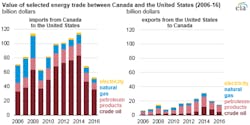US’ largest partner for energy trade is Canada
Graphic courtesy of the EIA
Energy accounted for about 5 percent of the value of all U.S. exports to Canada and more than 19 percent of the value of all U.S. imports from Canada in 2016, according to the latest annual data from the U.S. Census Bureau. This makes Canada the largest energy trading partner of the U.S., according to the U.S. Energy Information Administration (EIA). The value of U.S. energy imports from Canada in 2016 was $53 billion. The value of U.S. energy exports to Canada was $14 billion.
Crude oil averaged 3.3 million barrels per day (b/d) in 2016, representing the bulk of U.S. energy imports from Canada. Canada is the largest source of U.S. crude oil imports, providing 41 percent of total U.S. crude oil imports in 2016.
Projected carbon dioxide emissions drive fossil fuel use
The EIA’s projected consumption of petroleum and other liquid fuels weighs heavily on fuel economy standards for light-duty vehicles and for medium- and heavy-duty trucks. Projected use of these fuels varies depending on world oil prices that directly affect the prices of gasoline and distillate fuel oil and on production and disposition of hydrocarbon gas. These are among the several factors affecting fossil fuel use and the resulting level of energy-related CO2 emissions in the coming decades explored by the EIA in its nearly released Annual Energy Outlook 2017.
Graphic courtesy of the EIA
US crude oil and natural gas production experience saw 2016 decrease
Average crude oil production in the Lower 48 states dropped to 8.39 million barrels per day (b/d) last year, a decrease of about 0.55 million b/d, or 6.1 percent from the average in 2015, according to data in the EIA’s "Monthly Crude Oil, Lease Condensate, and Natural Gas Production Report." Natural gas gross withdrawals also dropped in the Lower 48 states in 2016, averaging 80.39 billion cubic feet per day (Bcf/d), or 1.03 Bcf/d – 1.3 percent lower than the previous year.
Earliest net increase in working gas stocks on record reported
Net injections into working gas storage typically do not occur until March and generally not before the week ending March 16. But net injections posted for the week ending Feb. 24 marked the earliest that working gas stocks posted net injections on a national level in the history of the Weekly Natural Gas Storage Report (WNGSR), which dates back to 1994. The report shows that working gas stocks rose 7 billion cubic feet (Bcf) in the Lower 48 states for the week ending Feb. 24, according to the U.S. Energy Information Administration (EIA).
Natural gas storage injection record in February for first time
The amount of natural gas in storage in the Lower 48 states rose 7 Bcf for the week ending Feb. 24. The marks first recorded natural gas injection during the week of February since the storage data has been collected, and can be attributed to warmer than normal temperatures throughout much of the U.S.




